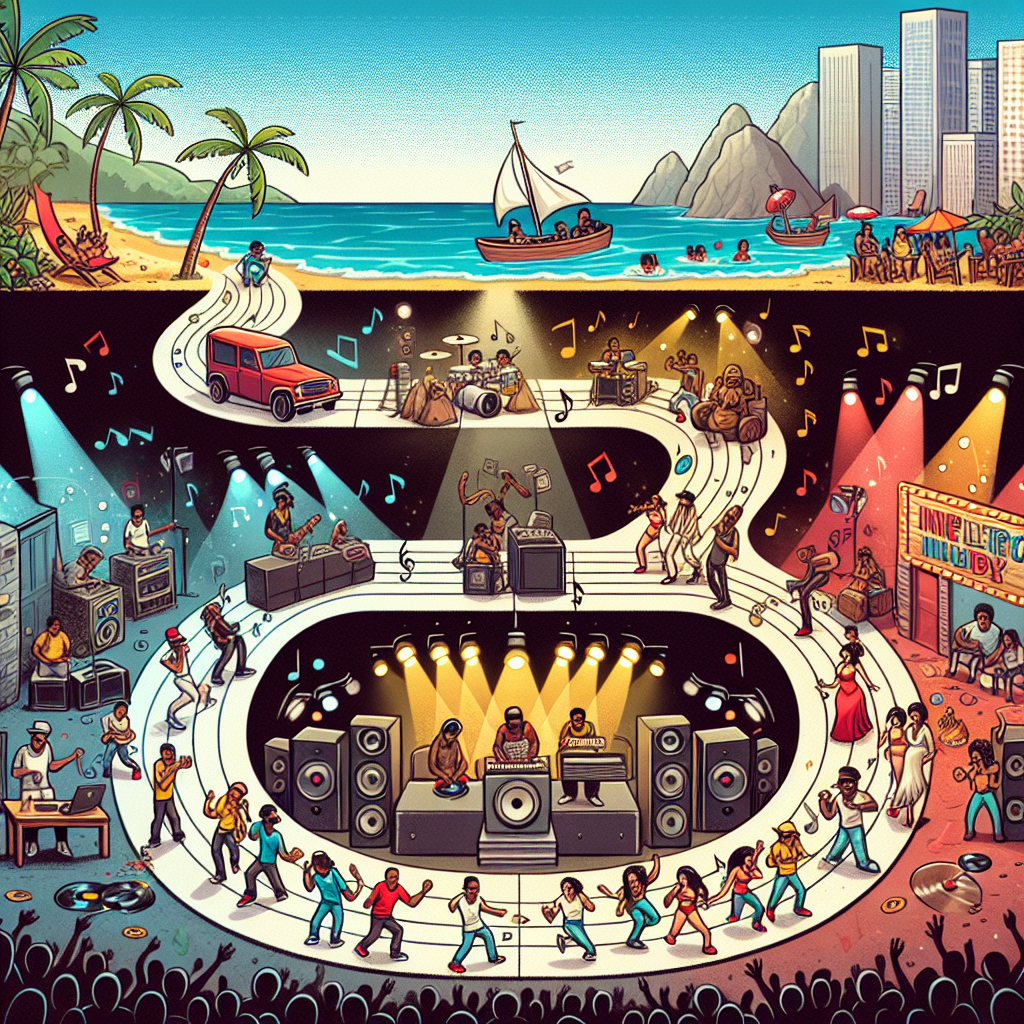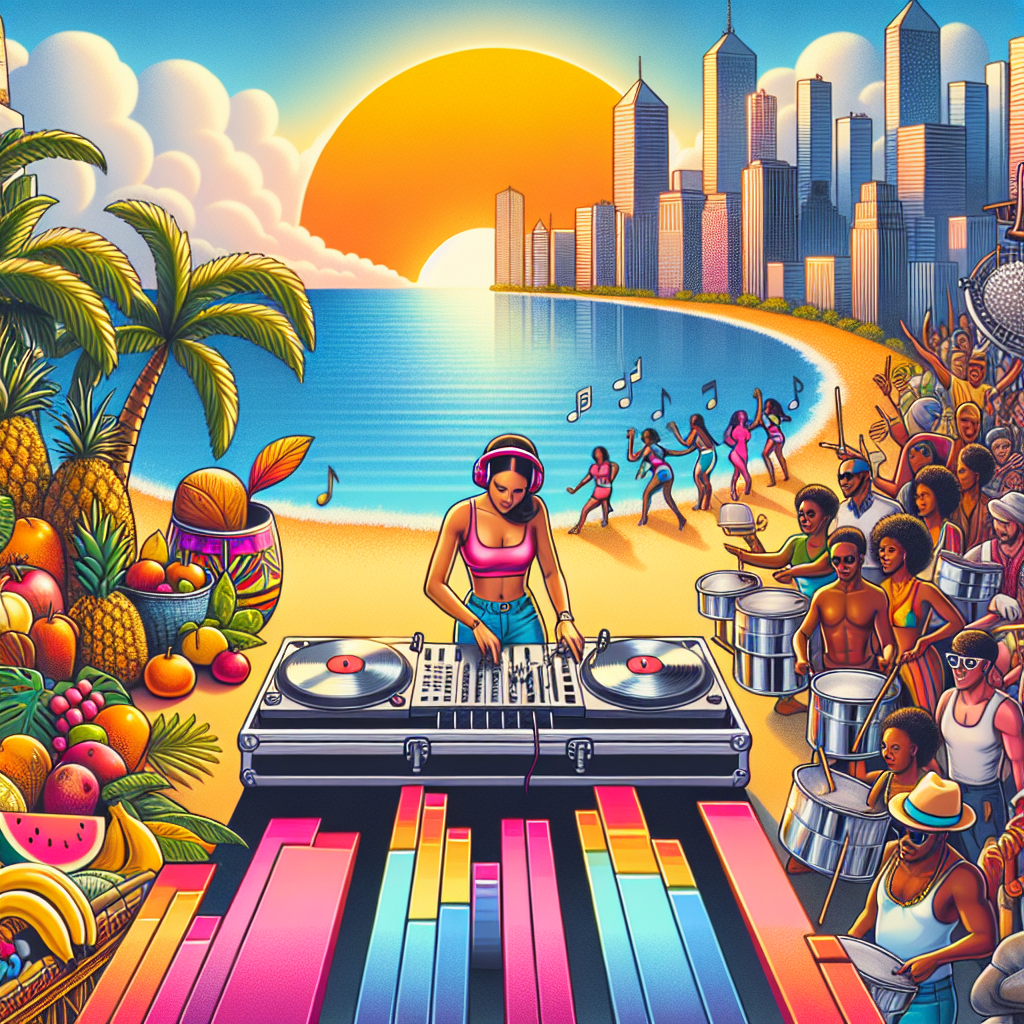“From Island Beats to Worldwide Streets: Tracing the Global Journey of Reggaeton”
Introduction
Reggaeton, a vibrant and pulsating music genre, has transcended its Caribbean origins to become a global phenomenon in the pop music scene. This genre, which blends Jamaican dancehall, reggae, and hip-hop, with Latin American influences such as salsa and bomba, originated in Puerto Rico in the late 20th century. It has since evolved, both musically and culturally, weaving its rhythms and narratives into the fabric of worldwide music consumption. The journey of reggaeton from local soundscapes to international stages offers a compelling study of cultural hybridization, technological advancements, and shifting music industry dynamics. This exploration delves into the roots of reggaeton, tracing its development and examining the socio-political and economic factors that have propelled its rise to global popularity.
The Evolution of Reggaeton: Tracing Its Origins in the Caribbean
Reggaeton, a vibrant blend of Latin rhythms, dancehall, and hip-hop, has transcended its humble beginnings to become a global phenomenon. This musical style, characterized by its infectious beats and compelling lyrics, has its roots deeply embedded in the Caribbean, a region known for its rich musical heritage. The journey of reggaeton from local sound to international sensation is not just a story of a genre, but a narrative of cultural fusion and resilience.
The origins of reggaeton can be traced back to Panama in the late 1970s and early 1980s when artists began experimenting with reggae en Español, a Spanish-language adaptation of Jamaican reggae. This new sound was the result of the cultural exchanges between Panama and Jamaica, facilitated by the significant Jamaican community in Panama, many of whom had come to work on the Panama Canal. The music spoke of daily life and struggles, resonating with many in the region.
As this new musical form made its way to Puerto Rico in the 1990s, it began to evolve further, incorporating elements of hip-hop, particularly the distinctive rhythmic style known as ‘Dem Bow.’ Puerto Rican artists like Daddy Yankee and Tego Calderón were instrumental in shaping the sound, adding a distinctly local flavor that included Puerto Rican bomba and plena rhythms. The term ‘reggaeton’ itself was coined in Puerto Rico, reflecting its reggae roots and the ‘tone’ of its new identity.
The transformation of reggaeton is a testament to the power of cultural synthesis. In Puerto Rico, the genre became a voice for the marginalized, a sound that echoed the socio-economic and political challenges faced by its communities. Lyrics often addressed themes of injustice, love, and life on the streets, wrapped in a rhythm that made it impossible not to dance. This blend of message and music struck a chord not only in the Caribbean but also in urban centers across Latin America and the United States, where Hispanic populations connected with its themes.
The international breakthrough of reggaeton can largely be attributed to the massive hit “Gasolina” by Daddy Yankee in 2004. The song’s global appeal showcased reggaeton’s potential to transcend language and cultural barriers, paving the way for other artists like Don Omar, Wisin & Yandel, and later, J Balvin and Bad Bunny. Each artist brought their unique influences and innovations, further diversifying the reggaeton sound and ensuring its place on the world stage.
Today, reggaeton is more than just a musical genre; it’s a cultural movement that continues to evolve and inspire. Its rhythm is a canvas for innovation, allowing artists to blend it with pop, electronic, and even rock elements. This adaptability is perhaps why reggaeton has sustained its popularity on global charts and continues to influence a wide array of other genres.
The story of reggaeton is a powerful reminder of how music can bridge diverse cultures and express universal emotions. From its roots in the Caribbean to its explosion onto the global pop scene, reggaeton has not only provided a soundtrack for celebration but has also offered a voice for those who weren’t heard. As it continues to evolve, reggaeton remains a symbol of artistic innovation and cultural pride, resonating with audiences around the world and inspiring a new generation of artists.
Influential Figures in Reggaeton: Pioneers Who Shaped the Genre

Reggaeton, a vibrant blend of Latin rhythms, dancehall, and hip-hop, has surged from its humble beginnings to dominate the global pop charts. The genre’s infectious beats and spirited lyrics have captivated audiences worldwide, but its journey to international acclaim is deeply rooted in the contributions of several key figures who pioneered and shaped its distinctive sound.
One cannot discuss the origins of reggaeton without mentioning El General, a Panamanian artist whose early ’90s tracks are often cited as some of the first examples of the genre. His song “Tu Pum Pum” is a classic that melded reggae rhythms with Spanish rap, setting the foundational sound that would evolve into reggaeton. El General’s music was not just pioneering in terms of sound but also in how it opened the door for other artists in Central America and the Caribbean to experiment with similar styles.
As reggaeton began to coalesce into a more defined genre, Puerto Rico emerged as its epicenter in the late 1990s and early 2000s. It was here that artists like Daddy Yankee and Don Omar took the stage, each playing a crucial role in shaping and popularizing reggaeton. Daddy Yankee’s “Gasolina,” released in 2004, became a global phenomenon, introducing many around the world to reggaeton for the first time. The song’s explosive energy and catchy chorus helped cement Daddy Yankee’s status as one of the genre’s leading figures.
Don Omar, another pivotal figure, contributed his own unique flair and lyrical depth to reggaeton. His track “Dale Don Dale” showcased his ability to blend traditional Latin sounds with the urban grit of reggaeton, creating a compelling narrative that resonated with a wide audience. His storytelling in songs bridged cultures and brought a new level of artistry to the genre.
The influence of these artists and others paved the way for a new generation of reggaeton stars. Figures like J Balvin and Bad Bunny have taken the baton, pushing the genre into new territories with their innovative sounds and global collaborations. J Balvin’s approach, particularly his emphasis on vibrant, cross-cultural beats, has helped reggaeton make significant inroads into the mainstream music scene, particularly in the United States and Europe.
Bad Bunny’s impact, meanwhile, has been characterized by his unique blend of introspection, style, and musical experimentation. His ability to mix traditional reggaeton with other genres like trap and rock has not only broadened his appeal but also challenged perceptions of what reggaeton can be. His album “X 100pre” broke numerous records and received critical acclaim, highlighting how far reggaeton has come from its roots.
The journey of reggaeton from local Caribbean parties to global pop charts is a testament to the creativity and resilience of its pioneers. These influential figures have not only shaped the sound of reggaeton but have also played a significant role in redefining Latin music on the world stage. Their contributions continue to inspire a new generation of artists who carry forward the rich, rhythmic legacy of reggaeton, ensuring that its beat—just like its history—remains vibrant and enduring. As we look to the future, the evolution of reggaeton remains an exciting prospect, promising even more innovative blends and cultural crossovers that will continue to enchant music lovers around the globe.
Reggaeton’s Global Journey: From Caribbean Rhythms to Worldwide Popularity
Reggaeton, a vibrant blend of Latin rhythms, dancehall, and hip-hop, has transcended its humble beginnings to become a global phenomenon. The genre’s infectious beats and spirited lyrics have captivated audiences far beyond its Caribbean roots, weaving a rich tapestry of cultural influence that spans continents. As we delve into the journey of reggaeton from local sound to worldwide sensation, it’s clear that this music is more than just entertainment; it’s a powerful expression of cultural identity and resilience.
The story of reggaeton begins in the late 20th century, where the warm breezes of Puerto Rico carried the sounds of Spanish reggae and bomba. These traditional forms, combined with influences from hip-hop and dancehall from neighboring Jamaica, created a unique sound that quickly became the heartbeat of the streets. Young artists, using rudimentary equipment in makeshift studios, began experimenting with these diverse musical styles, crafting the early sounds of what would soon be known as reggaeton.
As reggaeton began to take shape, its appeal was undeniable. The rhythm, known as “Dem Bow,” became a signature of the genre, its repetitive and catchy beats making it irresistible not to dance to. Lyrics often reflected the realities of life in Puerto Rico’s barrios, resonating with many who found their stories and struggles echoed in the music. This authenticity helped reggaeton forge a deep connection with its listeners, setting the stage for its spread across the Caribbean and eventually to the United States.
The transition of reggaeton into the U.S. market marked a significant turning point in its global journey. Cities with large Latino populations, such as New York and Miami, became hotbeds for reggaeton as local DJs began spinning tracks in clubs and on radio stations. The music’s universal appeal and adaptability allowed it to quickly permeate these multicultural communities, and before long, reggaeton was on its way to becoming a staple in the American music scene.
However, it was the advent of the internet and social media that truly catapulted reggaeton onto the global stage. Platforms like YouTube and Spotify enabled artists to share their music with the world, reaching listeners in places as far-flung as Tokyo and Berlin. The genre’s catchy hooks and dynamic rhythms proved universally appealing, transcending language barriers and cultural differences. Collaborations with high-profile artists from various genres further boosted reggaeton’s international profile, blending different musical styles and attracting a broader audience.
Today, reggaeton is more than just a genre; it’s a global movement. Artists like Daddy Yankee, J Balvin, and Bad Bunny have become household names, their concerts selling out arenas around the world. The music continues to evolve, incorporating elements from pop, electronic, and even rock, but it remains true to its roots, celebrating the vibrant cultures of the Caribbean and the voices of its people.
As reggaeton continues to spread its influence, it serves as a reminder of the power of music to bridge gaps between diverse cultures and communities. Its journey from the streets of Puerto Rico to the global stage is a testament to the enduring appeal of its rhythms and the universal language of its spirit. Reggaeton’s story is not just about music; it’s about perseverance, innovation, and the joy of shared human experience. As it moves forward, one can only imagine the new heights it will reach and the new audiences it will inspire.




